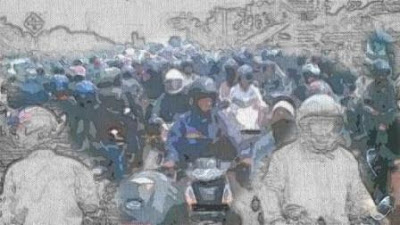Jakarta citizens are highly mobile due to their daily working schedules and business activities as well as social and other non-routine activities. Their mobility is supported by 7,5 million motorcycles of various kinds and more than 2 millions of cars, not to mention around 800,000 of public transportation of various kinds (300,000 buses and 500,000 other kinds of vehicles).
Considering the population in Greater Jakarta which is 20 million (9,5 million in the Metropolitan), the use of motorcycle excluding those having private cars is 1 : 3 in Jakarta. Recently, a total of 53 million units of motorcycles had been manufactured in Indonesia, of which as many as 50 million units were in circulation on the streets. Considering the population of Indonesia are 230 million, the use of motorcycles per capita in Indonesia was around 1: 5.
With such proportion, the sales of new motorcycles in Jakarta are still high, more than 3,000 motorcycles are sold per day. This is because of an easy purchasing pattern based on credit-backed multi-financing which eventually enhance the people’s purchasing-power for these two-wheeled vehicles. With a down payment of only Rp 500 thousand, one can directly bring home the vehicle worth of more than Rp 10 million.
With such kind of financing and the capability of the motorcycle industry to produce powerful, efficient (fuel consumption of around 40 kilometers per liter) and relatively cheap transportation mode, more people prefer to use motorcycles rather than public transportation. And here lies the problem. The more frequent the traffic jams, the more people try to use motorcycles instead of public transport causing more traffic jam. The travel of the motorcycles is now amounted to around 20 million trips per day.
Notwithstanding, hardly anybody is aware of the significant roles of motorcycles in the economic growth of the country. The authority overlooks the motorcycle role in increasing tremendously the mobility of the people to turn the business environment. Indonesia doesn't need to catch up with the developed countries to increase significantly the number of cars per capita in order to stimulate economic activities. In term of people mobility, as the country has 50 million motorcycles in addition to 10 million cars, their economic power is equivalent to the developed countries having 60 million cars (assuming that one car has two passengers).
The eagerness of using the motorcycles by middle and lower classes helps the country to shortcut the way towards the acceleration of its economic development. This is really a revolution through the transportation sector in Indonesia as one way to catch up with the economics of developed countries.
The eagerness of using the motorcycles by middle and lower classes helps the country to shortcut the way towards the acceleration of its economic development. This is really a revolution through the transportation sector in Indonesia as one way to catch up with the economics of developed countries.
The mobility of the motorcyclists shifts the location of new houses needed from the city into the suburbs up to around sixty kilometers out of the city which enlarges the area of Greater Jakarta today. Their mobility also helps to create good business activities and the environment as well as stimulates domestic tourist developments such as the establishment of new restaurants and new attractions especially in the surrounding areas having a special interest or good panorama.
Jakarta's infrastructure seems not ready to support such high growth of motorcycle usage. Currently, the total number of vehicles and a total length of roads which is around 7,650 kilometers in Jakarta are far from proportional. The road length extension is below 1% whereas the growth of car and motorcycles users is more than 6% annually.
The government should think more about providing the infrastructure for motorcycles, as they are relatively easy, inexpensive and efficient than cars. The regulators’ mindset should be changed. Banning or restricting motorcyclists crossing some protocol roads are counterproductive. The authorities should not regard the motorcycles solely as the source of the traffic jam but also as the power of the economic enhancement of the country.
The government should look for the way out of how the motorcyclists can more easily and safely travel across the city. They should be protected as far as possible from the fatal accident which may happen to them in riding between the vehicles through a very narrow escape between them. Every day at least three lives have lost due to road traffic accidents, about two of them are motorcyclists.
The traffic problem can be more easily reduced if adequate and safer, convenient, affordable, more integrated and timely public transportation is available. However, to develop such public transportation is not an easy task. It is far more inexpensive to change and educate the mentality of the motorcyclists for mutual respect, mutual care, obeying the rules, and throwing away the shortcut mentality. This effort should be continuously done by the entire community, reverberated by the rule of law firmly and consistently imposed by the related authorities.



No comments:
Post a Comment